One of the first challenges to set up a bearded dragon’s enclosure is choosing the best substrate.
The best Bearded Dragon substrate should be dry and not hold much humidity. This is because they are native to the deserts of Australia.
First time keepers often choose loose substrates like sand or wood shavings. This is a big mistake and can cause serious health issues such as impaction.
Luckily there are a wide variety of safe and affordable substrates.
Keep reading to learn about which substrates are best for a Bearded Dragon and which ones you should avoid.
Different Types of Bearded Dragon Substrate
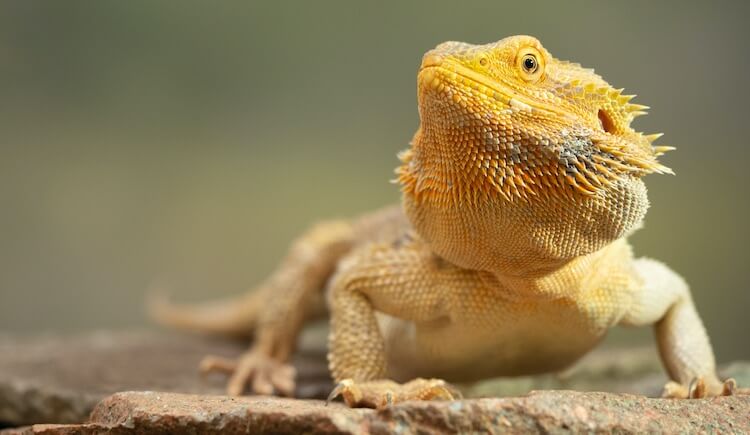
There are seven different types of substrate for Bearded Dragons:
- Reptile carpet, lino, fake grass or astroturf.
- Newspaper or paper towels.
- Ceramic tiles or slate.
- Rubber, shelf liner.
- Alfalfa pellets.
- Wood chips.
- Sand (e.g. play sand or calcium sand).
The best Bearded Dragon substrate will depend on your budget and how much effort you want to put into keeping it clean. If you do not mind regular cleaning then reptile carpet is a great choice.
Lower-maintenance substrates such as paper towels and tiles are excellent choices too.
Most of these substrates can be found at a pet or hardware store. If you are shopping at a hardware store then make sure the material is free from dangerous chemicals that could harm your lizard.
It is best not to use loose substrates such as sand and wood shavings.
Loose substrates can be bought in bulk and are cheap and easy to spot-clean. However, they can cause impaction if accidentally eaten. Impaction is a very serious health issue and the risk is especially high in baby bearded dragons.
7 Best Substrates for Bearded Dragons
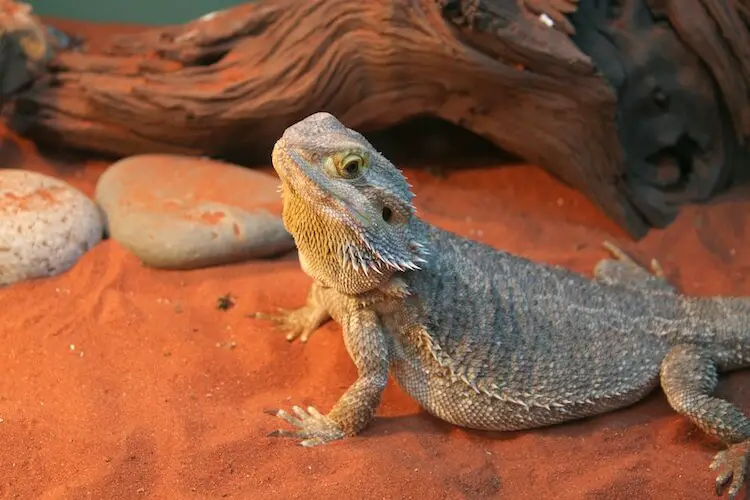
The best substrate is one that is safe, cheap, looks nice and is easy to clean.
The low humidity and high heat requirements of bearded dragons and other desert-dwelling lizards means their substrate should not hold humidity.
Every substrate has its own pros and cons.
For example tiles are easy to clean with no risk of impaction but are not as attractive as reptile carpet. Fake grass is appealing for its natural look. But it can be difficult to clean and crevices in the plastic can harbor bacteria if not properly disinfected.
Below we have ranked each Bearded Dragon substrate based on safety, suitability and appearance.
1. Reptile Carpet
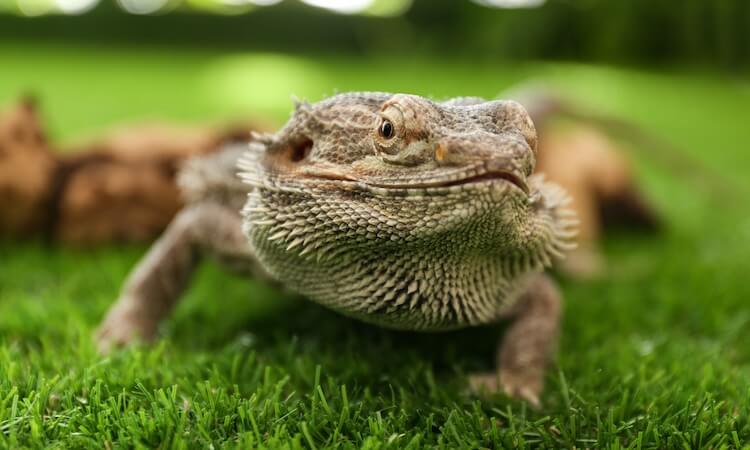
Pros
- Easy to install, safe, will not warp or overheat and a wide variety of patterns to choose from.
Cons
- Cleaning the carpets is very time-consuming and intensive.
Reptile carpet is a plastic or felt-based cloth made specifically for reptile terrariums.
It can be patterned or plain and usually comes in brown, green or tan. Some of the more expensive carpets are textured with rocks or grass for a more natural look.
When someone asks what substrate should I use for my Bearded Dragon, we always recommend reptile carpet.
Reptile carpet is the best substrate for bearded dragons of all ages.
Many keepers use reptile carpet for its understated and natural appearance.
Reptile carpet lasts for years and holds up well against the wears and tears of temperature fluctuations and lizard activity.
A disadvantage of using this substrate is that it needs to be taken out of the enclosure to be cleaned. It also takes several hours to air-dry. This means you will need to buy two carpets and swap them during cleaning.
Cheaper alternatives to this substrate include linoleum flooring or fake grass.
Lino can be purchased at any hardware store and is easy to cut and install. Unlike reptile carpet, lino is easy to clean with a washcloth. Unfortunately it doesn’t deal well with temperature fluctuations and will split and buckle.
Fake grass can be a tempting substrate to use because it looks like reptile carpet.
Unfortunately fake grass is very difficult to spot-clean and the uneven surface can trap bacteria. Also artificial grass “carpets” have tiny plastic loops that can catch your beardie’s toes or claw.
You should also never use real grass as it is difficult to maintain low humidity in a planted tank.
Annual Cost: $14 to $40 for two carpets.
2. Newspaper or Paper Towels
Pros
- A great low-cost substrate (especially for younger beardies), easily replaced and is not abrasive.
Cons
- Cannot be reused and is unattractive.
Newspapers or paper towels are an excellent low-cost substrate for a bearded dragon tank.
Both substrates provide even coverage, do not warp under heat and will not affect the humidity levels of your tank.
They are especially good for hatchlings and juveniles who are not heavy enough to tear through the paper.
Adult bearded dragons may inadvertently shred this substrate when climbing or exploring. However, this can quickly be rectified by weighing the substrate down with décor to help prevent damage and bunching.
Its cheap and quick replaceability makes up for its flimsiness.
Newspapers and paper towels are highly absorbent. Because of this they need to be cleaned more often than other substrates. This makes them less eco-friendly than permanent substrates such as tiles.
The largest disadvantage of using newspaper substrate is its artificial look.
For those who want to have a naturalistic habitat for their dragon this is not the best option.
However if you do not mind the appearance and want to save money then newspaper is perfect.
Annual Cost: $10.
3. Ceramic Tiles
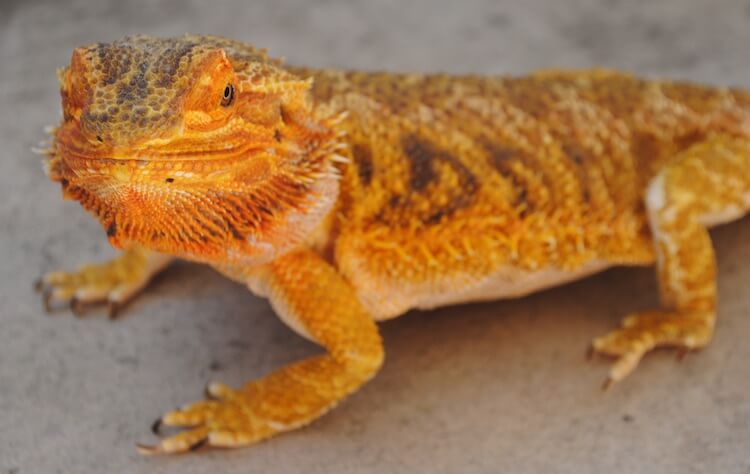
Pros
- Natural look, safe, and easy to clean.
Cons
- Difficult to install and not made for reptiles.
Ceramic tiles are a great choice for anyone who wants an attractive, cheap and eco-friendly substrate.
Unlike reptile carpet, tiles can be spot-cleaned and sanitized by wiping them with a cloth.
They also do not absorb moisture and will not warp when wet.
Ceramic is also a good conductor of heat so this substrate will not amplify or decrease the intensity of an under-tank heater.
This substrate has nearly every positive attribute.
The only downside is how difficult it is to cut and fit ceramic tiles to your tank’s specific dimensions.
Tiles usually come in 12” x 12” or 3” x 6” so it will need cutting to fit properly. Without the proper tools it is very difficult to cut ceramic cleanly and safely.
A very similar alternative to ceramic tiles is slate.
Slate is a fine-grained rock that is often used in landscaping but fits well into an indoor reptile tank. It is more textured and natural looking than ceramic but is much more expensive.
Total Cost: $5 to $20 for a 120-gallon tank.
4. Rubber Shelf Liner
Pros
- Durable and inexpensive substrate.
Cons
- Can crack or shrink if exposed to heat and does not maintain stable temperatures if placed over an under-tank heater.
Rubber shelf liners are more durable than paper towels or newspaper.
Shelf Liners are a cheap substrate that can be found at hardware and home goods stores. They vary in style and thickness.
Thinner mats are easy to cut with scissors and usually come in rolls large enough for multiple changes.
The biggest problem with using rubber liners as a bearded dragon substrate is that they are excellent thermal insulators and poor conductors.
This means they take much longer to heat up and cool down than other substrates. It makes it very tricky to maintain a proper temperature gradient that your bearded dragon needs to stay healthy.
Thinner rubber liners can also shrink or crack if exposed to high heat.
If you do decide to use shelf liners then pick a solid mat. Perforated mats are difficult to clean.
To prevent bacterial growth you should change this substrate every two weeks as it can absorb waste over time.
Annual Cost: $10 per roll.
5. Alfalfa Pellets
Pros
- Can be bought in bulk and is easy to replace.
Cons
- Some risk of impaction and quickly becomes moldy.
Alfalfa pellets are the best loose substrate for bearded dragons.
Normally this substrate is used as feed for rabbits and horses. However it can also be layered as a substrate for bearded dragons and other pet lizards.
If your dragon eats these pellets they can be safely digested. But, there is still a small risk of intestinal blockage.
Because of the risk of impaction we do not recommend sand, wood chips or alfalfa pellets.
Alfalfa pellets do not absorb much moisture so if they become wet they decompose rapidly and grow mold. Because of this they should be spot-cleaned daily.
You can find large bags of alfalfa pellets at pet stores, but buying enough to fill a 120-gallon tank can become expensive.
Annual Cost: $120 for a 120-gallon tank.
6. Wood Chips or Bark
Pros
- Look great, and is cheap and easy to clean.
Cons
- Some risk of impaction, and it absorbs moisture.
Wood chips and bark are another substrate that carry the risk of impaction.
Large adults can be housed on orchid bark if any small or sharp pieces are removed. Pine and cedar shavings should never be used, as they contain oils toxic to reptiles.
Babies and juveniles should not be kept on this substrate. They are likely to eat the shavings and splinters can irritate their skin.
Wood chips are known for absorbing moisture from the air and lowering the overall tank humidity. Bearded dragons need a low ambient humidity, but not enough moisture can lead to respiratory illnesses and retained shed.
Bark and wood pellets look great in a tank. But, it is up to you to decide if the risk of impaction is worth the visual appeal.
If you decide to use this substrate then you will need to feed your bearded dragon from a dish or container outside of tank to avoid accidental ingestion.
Annual Cost: $60 for a 120-gallon tank.
7. Sand
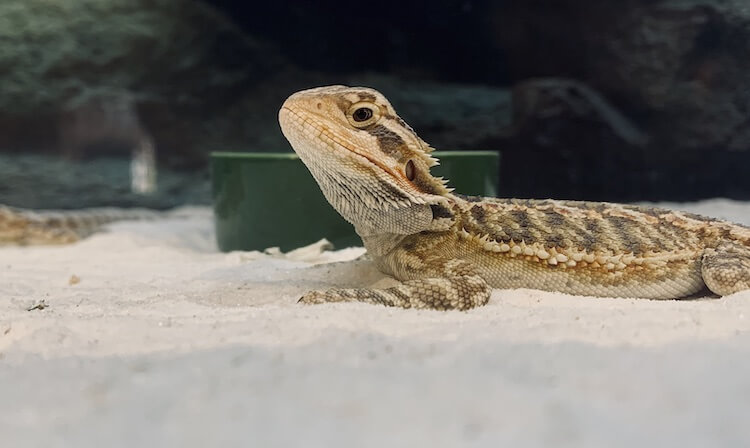
Pros
- Natural appearance and very easy to spot-clean.
Cons
- High risk of impaction and it cannot be reused.
Sand is unfortunately the most popular bearded dragon substrate.
The use of sand in bearded dragon enclosures comes from a common myth. First time keepers think the sand sold in pet stores is the same as the sand in their natural habitat.
Sand is often sold as ‘calcium sand’, ‘reptile sand’ or ‘play sand.’
In reality the scrub deserts that wild Bearded Dragon’s live in is made up of a more compacted clay-like sand than the loose type substrate sold in pet stores.
First time keepers purchase sand substrate because of its natural appearance and ease of cleaning.
Sand is easy to spot-clean with a scoop or sieve.
Unfortunately. Beardies that eat sand in search of calcium can get an impaction. It is also very dusty so gets in their water, food, and eyes.
Avoid any sand as a substrate, especially silica sand. It has sharp-edged grains that can harm your dragon’s gastrointestinal tract even without impaction.
Annual Cost: $60 for a 120-gallon tank.
Comparison Table
| Substrate | Pros | Cons | Rank |
|---|---|---|---|
| Reptile Carpet | Easy to install, safe, will not warp or overheat and a wide variety of patterns to choose from. | Cleaning is very time-consuming and intensive. | 1 |
| Newspaper or Paper Towels | A great low-cost substrate (especially for younger beardies), easily replaced and is not abrasive. | Cannot be reused and is unattractive. | 2 |
| Ceramic Tiles | Natural look, safe, and easy to clean. | Difficult to install and not made for reptiles. | 3 |
| Rubber Shelf Liner | Durable and cheap substrate. | Can crack or shrink if exposed to heat and does not maintain stable temperatures if placed over an under-tank heater. | 4 |
| Alfalfa Pellets | Can be bought in bulk and is easy to replace. | Low risk of impaction and quickly become moldy. | 5 |
| Wood Chips or Bark | Look great, cheap and easy to clean. | Low risk of impaction and it absorbs moisture. | 6 |
| Sand | Natural appearance and very easy to spot-clean. | High risk of impaction and it cannot be reused. | 7 |
How Often To Change Bearded Dragon Substrate?
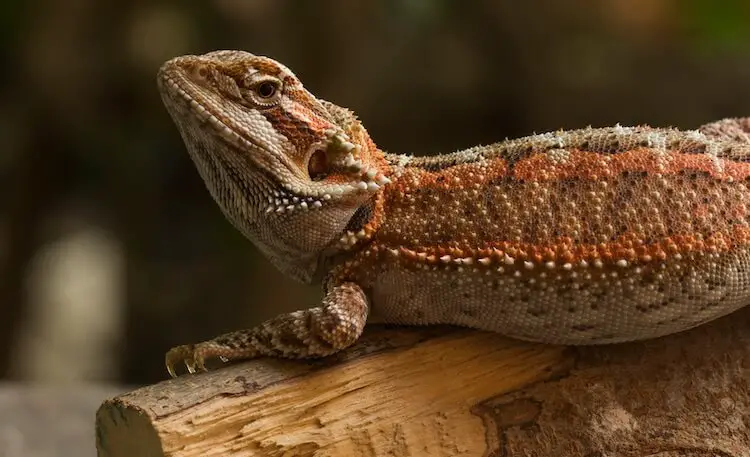
A Bearded Dragon’s substrate should be spot-cleaned daily to any avoid bacterial growth.
As well as keeping the tank clean, spot-cleaning is also a great way to check on your dragon’s digestive health. Their feces should be brown and solid with a white urate. Unusual feces or an absence of feces can be an indicator that your lizard has is sick.
Substrate should be deep-cleaned or fully replaced every two weeks.
For paper towels or newspaper this is as easy as throwing away the old layer and replacing it with new substrate.
Reptile carpet should be removed and hand washed with hot water and dish soap.
Permanent substrates (e.g. ceramic tiles, slate, or rubber) should be sprayed down with a reptile-safe cleaning agent:
- A 1-3 oz./1 qt. diluted mix of bleach and water.
- A gentle unscented dish soap.
- White vinegar.
Remember to remove your Bearded Dragon from the enclosure before changing the substrate.
Make sure that the tank and substrate are completely dry and free of soap before returning your Beardie.
Should You Use Sand For A Bearded Dragon?
No. In captivity your Bearded Dragon can accidentally ingest sand substrate when hunting and eating. Over time sand will build up and create a blockage in his gastrointestinal tract that can be fatal.
Young or sick dragons are more likely to eat sand and develop an impaction.
For this reason it is best not to use loose substrates such as sand.
Summary
The best substrate for a Bearded Dragon is reptile carpet.
Reptile carpet is found at almost any pet store and can be cut to size with scissors. From experience buying two carpets makes it simple to switch them out during cleaning.
They also come in a wide variety of colors and patterns so you can match it easily with your Bearded Dragon’s décor.
Ceramic tiles also make a great choice but it can be difficult to cut and fit!
Loose substrates (e.g. sand, wood shavings and alfalfa pellets) should be avoided. They can look fantastic but the risk of impaction is too high.
What substrate do you use for your pet Beardie? Let us know below.

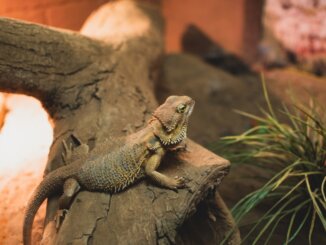
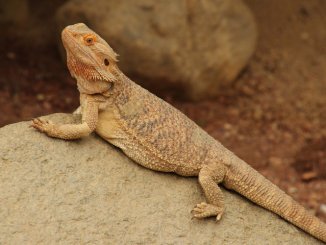
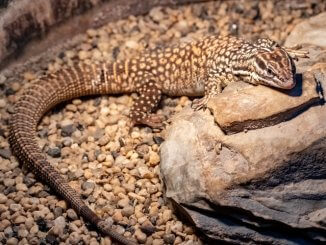

Reptile carpet, lino, fake grass or astroturf. – No, traps/holds bacteria.
Newspaper or paper towels. – Newspaper yes, paper towel no, they can eat it.
Ceramic tiles or slate. – Bad for joints
Rubber, shelf liner. – Off gassing issues.
Alfalfa pellets. – No clue
Wood chips. – No.
Sand (e.g. play sand or calcium sand). – Calcium sand is the worst.
The best substrate for bearded dragons is a mix of organic top soil, play sand and orchid bark.